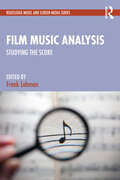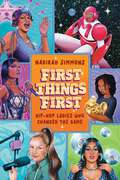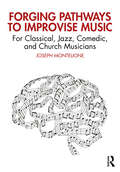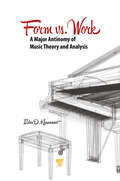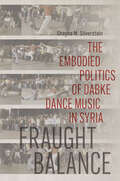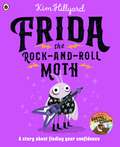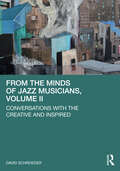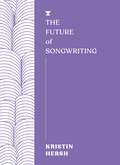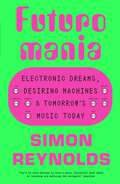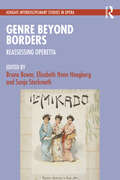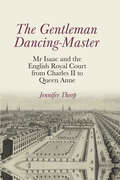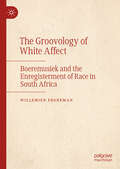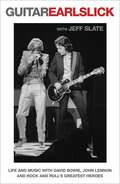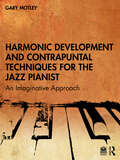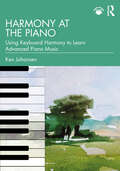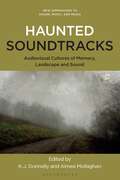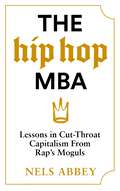- Table View
- List View
Film Music Analysis: Studying the Score (Routledge Music and Screen Media Series)
by Frank LehmanSince the establishment of film music studies, there has been a steady growth of serious analytical work on the film music repertoire. Film Music Analysis: Studying the Score offers the first collection of essays dedicated to the close investigation of musical structure and meaning in film music. Showcasing scholarship from a diverse and distinguished group of music theorists and musicologists, this book presents the many ways to inspect the inner workings of film music in a manner that is exciting and accessible to anyone curious about this music, regardless of their background in film or music theory.Each chapter takes as its focus one music-theoretical parameter and explores how that concept can be used to analyze and interpret film music. Covering theoretical concepts that range from familiar categories such as leitmotif and pitch structure to more cutting-edge ideas such as timbral associativity, topic theory, and metrical states, the book provides a toolkit with which to explore this captivatingly varied repertoire. With example analyses drawn from classic and contemporary films, Film Music Analysis: Studying the Score is a valuable teaching tool and an indispensable addition to the library of any lover of film and music.
Film Music Analysis: Studying the Score (Routledge Music and Screen Media Series)
Since the establishment of film music studies, there has been a steady growth of serious analytical work on the film music repertoire. Film Music Analysis: Studying the Score offers the first collection of essays dedicated to the close investigation of musical structure and meaning in film music. Showcasing scholarship from a diverse and distinguished group of music theorists and musicologists, this book presents the many ways to inspect the inner workings of film music in a manner that is exciting and accessible to anyone curious about this music, regardless of their background in film or music theory.Each chapter takes as its focus one music-theoretical parameter and explores how that concept can be used to analyze and interpret film music. Covering theoretical concepts that range from familiar categories such as leitmotif and pitch structure to more cutting-edge ideas such as timbral associativity, topic theory, and metrical states, the book provides a toolkit with which to explore this captivatingly varied repertoire. With example analyses drawn from classic and contemporary films, Film Music Analysis: Studying the Score is a valuable teaching tool and an indispensable addition to the library of any lover of film and music.
First Things First: Hip-Hop Ladies Who Changed the Game
by Nadirah SimmonsThis enlightening book reframes the history of hip-hop—and this time, women are given credit for all their trailblazing achievements that have left an undeniable impact on music. FIRST THINGS FIRST, hip-hop is not just the music, and women have played a big role in shaping the way it looks today. FIRST THINGS FIRST takes readers on a journey through some notable firsts by women in hip-hop history and their importance. Factual firsts like Queen Latifah becoming the first rapper to get a star on the Hollywood Walk of Fame, Lauryn Hill making history as the first rapper to win the coveted Album of the Year Award at the GRAMMYs, April Walker being the first woman to dominate in the hip-hop fashion game, and Da Brat being the first solo woman rapper to have an album go platinum, and metaphorical firsts like Missy Elliott being the first woman rapper to go to the future. (Trust me, she really did.) There are chapters on music legends like Nicki Minaj, Lil&’ Kim and Mary J. Blige, tv and radio hosts like Big Lez and Angie Martinez, and so many more ladies I would name but I don&’t want to spoil the book! There are games, charts and some fire images, too. Altogether, FIRST THINGS FIRST is a celebration of the achievements of women in hip-hop who broke down barriers and broke the mold. So the next time someone doesn&’t have their facts straight on the ladies in hip-hop, you can hit them with &“first things first&”…
Forging Pathways to Improvise Music: For Classical, Jazz, Comedic, and Church Musicians
by Joseph MontelioneA step-by-step resource on forging one’s own pathway to improvise music, this book guides the musician through a clear and simple method that will easily translate to the reader’s genre of choice. Many musicians struggle with improvisation. Coincidentally, educators also find it challenging to integrate improvisation into curriculum. This book breaks down the barriers most performers and educators combat in the learning and teaching of improvisation, and is a helpful approach to demystify the complicated sphere of music improvisation. Divided into three sections, the first part of the book helps the reader develop an improvisatorial mindset to mentally conceive musical ideas, regardless of genre. The second portion then connects the improviser’s mindset to translating those ideas into a compelling musical performance in real time. The book’s final third assists the reader with discovering how to apply this method of improvisation to the nuanced liturgical, comedic, jazz, and classical styles. Forging Pathways to Improvise Music offers a practical introduction to improvisational methods essential for educators, students, and musicians of diverse educational backgrounds and musical genres.
Forging Pathways to Improvise Music: For Classical, Jazz, Comedic, and Church Musicians
by Joseph MontelioneA step-by-step resource on forging one’s own pathway to improvise music, this book guides the musician through a clear and simple method that will easily translate to the reader’s genre of choice. Many musicians struggle with improvisation. Coincidentally, educators also find it challenging to integrate improvisation into curriculum. This book breaks down the barriers most performers and educators combat in the learning and teaching of improvisation, and is a helpful approach to demystify the complicated sphere of music improvisation. Divided into three sections, the first part of the book helps the reader develop an improvisatorial mindset to mentally conceive musical ideas, regardless of genre. The second portion then connects the improviser’s mindset to translating those ideas into a compelling musical performance in real time. The book’s final third assists the reader with discovering how to apply this method of improvisation to the nuanced liturgical, comedic, jazz, and classical styles. Forging Pathways to Improvise Music offers a practical introduction to improvisational methods essential for educators, students, and musicians of diverse educational backgrounds and musical genres.
Form vs. Work: A Major Antinomy of Music Theory and Analysis
by Ildar D. KhannanovThe antinomy of musical work and musical form has been central for music theory for centuries. Musical work is complete and all-inclusive, which makes it an ideal object of study. However, the teaching of musical form, albeit selective, is self-sufficient and epistemologically sovereign. The book offers both the historical overview and the analytical discourse on this antinomy in both Western and Russian perspectives. It presents an insider’s view of the latter and contains materials never previously published.
Form vs. Work: A Major Antinomy of Music Theory and Analysis
by Ildar D. KhannanovThe antinomy of musical work and musical form has been central for music theory for centuries. Musical work is complete and all-inclusive, which makes it an ideal object of study. However, the teaching of musical form, albeit selective, is self-sufficient and epistemologically sovereign. The book offers both the historical overview and the analytical discourse on this antinomy in both Western and Russian perspectives. It presents an insider’s view of the latter and contains materials never previously published.
Fraught Balance: The Embodied Politics of Dabke Dance Music in Syria (Music / Culture)
by Shayna M. SilversteinDabke, one of Syria's most beloved dance music traditions, is at the center of the country's war and the social tensions that preceded conflict. Drawing on almost two decades of ethnographic, archival, and digital research, Shayna M. Silverstein shows how dabke dance music embodies the fraught dynamics of gender, class, ethnicity, and nationhood in an authoritarian state. The book situates dabke politically, economically, and historically in a broader account of expressive culture in Syria's recent (and ongoing) turmoil. Silverstein shows how people imagine the Syrian nation through dabke, how the state has coopted it, how performances of masculinity reveal—and play with—the tensions and complexities of the broader social imaginary, how forces opposed to the state have used it resistively, and how migrants and refugees have reimagined it in their new homes in Europe and the United States. She offers deeply thoughtful reflections on the ethnographer's ethical and political dilemmas on fieldwork in an authoritarian state. Silverstein's study ultimately questions the limits of authoritarian power, considering the pleasure and play intrinsic to dabke circles as evidence for how performance cultures sustain social life and solidify group bonds while reproducing the societal divides endemic to Syrian authoritarianism.
Frida the Rock-and-Roll Moth: A story about finding your confidence
by Kim HillyardA NEW picture book from the winner of the Best Illustrated Book, Waterstones Children's Prize 2023.Frida is a musical moth who loves to rock out - she puts on her pointy boots and plays her purple guitar really LOUD! But when the Big Bright Light is switched on, more moths appear, ready to rock together, and Frida starts to feel that everyone is much better than her. Perhaps she isn't so rock-and-roll after all . . .With the help of her biggest fan, Auntie Edna, Frida learns to reclaim her style, find her confidence and get up and rock on once more!This positive picture book will inspire readers to find what makes them feel good and let their inner confidence shine.Kim Hillyard creates positive, heart-warming stories that are designed to empower and inspire young readers. Each picture book focuses on a different feeling or belief to help children navigate the world around them.Also available from Kim Hillyard:Mabel and the Mountain: a story about believing in yourselfNed and the Great Garden Hamster Race: a story about kindnessGretel The Wonder Mammoth: a story about overcoming anxietyFlora and Nora Hunt for Treasure: a story about the power of friendship
From the Minds of Jazz Musicians, Volume II: Conversations with the Creative and Inspired
by David SchroederFrom the Minds of Jazz Musicians, Volume II is a follow-up to Volume I’s celebration of contemporary jazz artists who have toiled, struggled and succeeded in finding their creative space. Volume II was developed through transcribing and editing selected interviews with 29 jazz artists, conducted by the author since 2011, along with a historical essay on each artist. The interviews feature musicians from a broad range of musical styles and experiences, with their beginnings ranging from the 50s to the early 80s. Topics range from biographical life histories to descriptions of mentor relationships, revealing the important life lessons they learned along the way. With the goal to discover the person behind the persona, the author elicits conversations that speak of the creative process, mining the individualistic perspectives of seminal artists who witnessed history in the making. By comparing and contrasting each artist’s perspective to discover similarities in their career paths. these volumes are an important research tool for students and academics, offering direct information from leading figures in the jazz world.
From the Minds of Jazz Musicians, Volume II: Conversations with the Creative and Inspired
by David SchroederFrom the Minds of Jazz Musicians, Volume II is a follow-up to Volume I’s celebration of contemporary jazz artists who have toiled, struggled and succeeded in finding their creative space. Volume II was developed through transcribing and editing selected interviews with 29 jazz artists, conducted by the author since 2011, along with a historical essay on each artist. The interviews feature musicians from a broad range of musical styles and experiences, with their beginnings ranging from the 50s to the early 80s. Topics range from biographical life histories to descriptions of mentor relationships, revealing the important life lessons they learned along the way. With the goal to discover the person behind the persona, the author elicits conversations that speak of the creative process, mining the individualistic perspectives of seminal artists who witnessed history in the making. By comparing and contrasting each artist’s perspective to discover similarities in their career paths. these volumes are an important research tool for students and academics, offering direct information from leading figures in the jazz world.
Futuromania: Electronic Dreams, Desiring Machines and Tomorrow’s Music Today
by Simon ReynoldsSimon Reynolds's first book in eight years is a celebration of music that feels like a taste of tomorrow. Sounds that prefigure pop music's future - the vanguard genres and heroic innovators whose discoveries eventually get accepted by the wider mass audience. But it's also about the way music can stir anticipation for a thrillingly transformed world just around the corner: a future that might be utopian or dystopian, but at least will be radically changed and exhilaratingly other. Starting with an extraordinary chapter on Giorgio Moroder and Donna Summer, taking in illuminating profiles of Ryuichi Sakamoto, Boards of Canada, Burial, and Daft Punk, and arguing for Auto-Tune as the defining sound of 21st century pop, Futuromania shapes over two-dozen essays and interviews into a chronological narrative of machine-music from the 1970s to now. Reynolds explores the interface between pop music and science fiction's utopian dreams and nightmare visions, always emphasising the quirky human individuals abusing the technology as much as the era-defining advances in electronic hardware and digital software. A tapestry of the scenes and subcultures that have proliferated in that febrile, sexy and contested space where man meets machine, Futuromania is an enthused listening guide that will propel readers towards adventures in sound. There is a lifetime of electronic listening here.
Genre Beyond Borders: Reassessing Operetta (Ashgate Interdisciplinary Studies in Opera)
This book offers an innovative approach to understanding operetta, drawing attention to its malleability and resistance to boundaries. These shows have traversed (and continue to traverse) with ease the national borders which might superficially define them, or draw on features from many other genres without fundamentally changing in tone or approach. The chapters move from nineteenth-century London and Paris to twentieth-century North America, South America and Europe to present-day Australia. Some offer fresh understandings of familiar composers, such as Johann Strauss or Gilbert and Sullivan, while others examine works or composers that are less well-known. The chapter on Socialist operetta in Czechoslovakia in particular will almost certainly be a revelation to anyone from Western Europe or the US, where operetta is often understood to be a bourgeois phenomenon. As a summary of the current state of the field, this collection showcases the many possible pathways for future scholars who wish to explore it.
Genre Beyond Borders: Reassessing Operetta (Ashgate Interdisciplinary Studies in Opera)
by Bruno Bower, Elisabeth Honn Hoegberg, and Sonja StarkmethThis book offers an innovative approach to understanding operetta, drawing attention to its malleability and resistance to boundaries. These shows have traversed (and continue to traverse) with ease the national borders which might superficially define them, or draw on features from many other genres without fundamentally changing in tone or approach. The chapters move from nineteenth-century London and Paris to twentieth-century North America, South America and Europe to present-day Australia. Some offer fresh understandings of familiar composers, such as Johann Strauss or Gilbert and Sullivan, while others examine works or composers that are less well-known. The chapter on Socialist operetta in Czechoslovakia in particular will almost certainly be a revelation to anyone from Western Europe or the US, where operetta is often understood to be a bourgeois phenomenon. As a summary of the current state of the field, this collection showcases the many possible pathways for future scholars who wish to explore it.
The Gentleman Dancing-Master: Mr Isaac and the English Royal Court from Charles II to Queen Anne (Clemson University Press: Studies in British Musical Cultures)
by Jennifer ThorpThe Gentleman Dancing-Master: Mr Isaac and the English Royal Court from Charles II to Queen Anne is a study of the life of the most significant dancing-master at the late-Stuart court in London. It discusses his use of dance music and brings together, for the first time, reprints of the notations of all his twenty-three surviving dances created for performance at court in the presence of the monarch, including several created to celebrate the birthdays of Queen Anne or named after important courtiers or political events. This study highlights the significance of dance as a central part of court culture, and also the wider context of the London book trade within which Isaac’s notators turned his dances into a publishable form ultimately taken over by John Walsh’s music publishing firm. Using extensive archival and printed sources from his day, the book follows Isaac’s career as a dancer, teacher, and choreographer of sophisticated duets in the fashionable French style, some of which were also performed in the theatre. Isaac, however, was no slavish follower of French fashion, and by careful consideration of the extant dances from the point of view of a dancer, this study also seeks to throw light on Isaac’s often individualistic approach to choreography.
The Groovology of White Affect: Boeremusiek And The Enregisterment Of Race In South Africa
by Willemien FronemanGuitar: A rock 'n' roll tell-all autobiography from David Bowie's sideman
by Jeff Slate Earl SlickRead this rollicking rock 'n' roll memoir of the last 50 years of rock history, from David Bowie's longest serving lead guitarist and legendary sideman, Earl Slick. He's played with everyone from John Lennon to the New York Dolls – and he's got the stories to prove it.----‘Earl is a legendary guitar star. His playing is earth, timeless and never less than stellar’ DAVID BOWIE ‘You play mean ass blues for a skinny ass white boy’ BUDDY GUY ‘Had a good night out did we . . .?’ JOHN LENNON Earl Slick was barely out of his teens when David Bowie hired him to play guitar on the ground-breaking 1974 Diamond Dogs tour. It marked the beginning of a relationship that would endure through thick and thin for the next forty years. Gracing classic albums like Young Americans, Station to Station and the 2013 comeback, The Next Day, Slick played on the tour that followed Bowie’s smash hit Let’s Dance album and was at his side for the epic Glastonbury show in 2000. But it wasn’t just Bowie. The young guitarist was in John Lennon’s band at the time of the former Beatle’s tragic murder. Other collaborations read like a roll call of rock ‘n’ roll royalty including Mick Jagger, The Cure, George Harrison, Ringo Starr, Joe Cocker, Buddy Guy, Ian Hunter, David Coverdale and Eric Clapton. And in the ‘80s he became an MTV star in his own right with the success of Phantom, Rocker and Slick. Through it all he lived the rock ‘n’ roll life to the hilt. Until it nearly killed him. One of rock’s great sidemen, Earl Slick was in the room when music history was made. Guitar takes us there, shining a light on superstars like Bowie and Lennon, while recounting the extraordinary story of the boy from New York City who became a real-life Johnny B. Goode.
»Hands Across the Sea« - John Philip Sousa und der musikalische Amerikanismus in Kontinentaleuropa (Musik und Klangkultur #60)
by Tobias FaßhauerDer Dirigent und Komponist John Philip Sousa (1854-1932) war eine Ikone der amerikanischen Massenkultur um 1900. Seine Märsche und die internationalen Tourneen seines zivilen Blasorchesters machten ihn zu einem der bekanntesten Musiker seiner Zeit. Tobias Faßhauer zeichnet erstmals Sousas kontinentaleuropäische Konzertreisen nach, um seine Rolle im frühen Transfer amerikanischer populärer Musik nach Europa aufzudecken. Eingebettet in den Kontext der Debatte über Amerikanismus zu Beginn des 20. Jahrhunderts entsteht so ein luzides Bild von der Rezeption und dem Einfluss Sousas auf die europäische Musik.
Harmonic Development and Contrapuntal Techniques for the Jazz Pianist: An Imaginative Approach
by Gary MotleyHarmonic Development and Contrapuntal Techniques for the Jazz Pianist serves as a guide for harmonic expansion and development for jazz piano, offering pianists both a rationale and methods to improve contrapuntal hand techniques. The text focuses on the relationship between theory and execution and both of those components’ usefulness in creating a jazz sound at the piano. This kinaesthetic method provides the learner with a systematic approach to harmonic movement, revealing options that may not have been otherwise apparent. This method will allow pianists to add depth and dimension to their chord voicings in the same way that vocalists and wind instrumentalists give character and shape to the notes they create. Key features include musical examples ranging from singular chord construction to sophisticated harmonic progressions and song application. Performance exercises are provided throughout the text. Learners and instructors are encouraged to create their own exercises. Related ancillaries at harmoniccounterpoint.com include: Musical examples Audio tracks Performance exercises Written assignments Intended for the learner who is reasonably familiar with essential jazz harmony, this textbook will be both a significant resource for the advanced player and a fundamental component for the learner in a structured academic musical setting.
Harmonic Development and Contrapuntal Techniques for the Jazz Pianist: An Imaginative Approach
by Gary MotleyHarmonic Development and Contrapuntal Techniques for the Jazz Pianist serves as a guide for harmonic expansion and development for jazz piano, offering pianists both a rationale and methods to improve contrapuntal hand techniques. The text focuses on the relationship between theory and execution and both of those components’ usefulness in creating a jazz sound at the piano. This kinaesthetic method provides the learner with a systematic approach to harmonic movement, revealing options that may not have been otherwise apparent. This method will allow pianists to add depth and dimension to their chord voicings in the same way that vocalists and wind instrumentalists give character and shape to the notes they create. Key features include musical examples ranging from singular chord construction to sophisticated harmonic progressions and song application. Performance exercises are provided throughout the text. Learners and instructors are encouraged to create their own exercises. Related ancillaries at harmoniccounterpoint.com include: Musical examples Audio tracks Performance exercises Written assignments Intended for the learner who is reasonably familiar with essential jazz harmony, this textbook will be both a significant resource for the advanced player and a fundamental component for the learner in a structured academic musical setting.
Harmony at the Piano: Using Keyboard Harmony to Learn Advanced Piano Music
by Ken JohansenHarmony at the Piano adapts the traditional study of keyboard harmony to the practical needs of modern piano students, using innovative exercises to help students practice their repertoire more deliberately, consciously, and creatively. The author introduces the essential elements of harmony through extensive examples from real piano music. Rooted in the understanding that the language of tonal harmony is best assimilated at the keyboard, this textbook: Gives students effective practice methods for learning repertoire, including techniques for memorizing music in a deliberate, analytical way. Connects harmony to musical expression, enabling students to make interpretive decisions based on their understanding of harmony. Contains extensive practice drills in each chapter, including chord progressions, figured bass, melody harmonization, reduction techniques, transposition, repertoire study, and more. Designed to support a full college or conservatory course in keyboard harmony, this book clearly connects the study of harmony to practical musicianship and keyboard skills, providing an essential resource for all instructors and students of advanced piano music. Extensive online resources complement this textbook, including suggested realizations of the figured bass exercises, the original scores of the melody harmonization and fill-in-the-blank exercises, as well as additional exercises and examples.
Harmony at the Piano: Using Keyboard Harmony to Learn Advanced Piano Music
by Ken JohansenHarmony at the Piano adapts the traditional study of keyboard harmony to the practical needs of modern piano students, using innovative exercises to help students practice their repertoire more deliberately, consciously, and creatively. The author introduces the essential elements of harmony through extensive examples from real piano music. Rooted in the understanding that the language of tonal harmony is best assimilated at the keyboard, this textbook: Gives students effective practice methods for learning repertoire, including techniques for memorizing music in a deliberate, analytical way. Connects harmony to musical expression, enabling students to make interpretive decisions based on their understanding of harmony. Contains extensive practice drills in each chapter, including chord progressions, figured bass, melody harmonization, reduction techniques, transposition, repertoire study, and more. Designed to support a full college or conservatory course in keyboard harmony, this book clearly connects the study of harmony to practical musicianship and keyboard skills, providing an essential resource for all instructors and students of advanced piano music. Extensive online resources complement this textbook, including suggested realizations of the figured bass exercises, the original scores of the melody harmonization and fill-in-the-blank exercises, as well as additional exercises and examples.
Haunted Soundtracks: Audiovisual Cultures of Memory, Landscape, and Sound (New Approaches to Sound, Music, and Media)
by K. J. Donnelly and Aimee MollaghanThe turn of the millennium has heralded an outgrowth of culture that demonstrates an awareness of the ephemeral nature of history and the complexity underpinning the relationship between location and the past. This has been especially apparent in the shifting relationship between landscape, memory and sound in film, television and other media. The result is growing interest in soundtracks, as part of audiovisual culture, as well as an interest in the spectral aspects of culture more generally. This collection of essays focuses on audiovisual forms that foreground landscape, sound and memory. The scope of inquiry emphasises the ghostly qualities of a certain body of soundtracks, extending beyond merely the idea of 'scary films' or 'haunted houses.' Rather, the notion of sonic haunting is tied to ideas of trauma, anxiety or nostalgia associated with spatial and temporal dislocation in contemporary society. Touchstones for the approach are the concepts of psychogeography and hauntology, pervasive and established critical strategies that are interrogated and refined in relation to the reification of the spectral within the soundtracks under consideration here.
The Hip-Hop MBA: Lessons in Cut-Throat Capitalism from Rap’s Moguls
by Nels AbbeyWhat does the founding of the Sugarhill Gang teach us about business development? What can we learn about management and leadership from Jay-Z’s decades-long dominance? What does Ice Cube’s refusal to accept $75,000 to remain a member of NWA tell us about risk management? What can we learn about market dominance from the Death Row and Bad Boy Records beef? What does the rise and fall of MC Hammer (and the near fall of Rihanna) reveal about the psychology of money management? Does Lil Nas X have anything to teach us about corporate diversity? In The Hip Hop MBA, banker–turned–writer Nels Abbey offers an alternative and entertaining look at business and economics through the rise and triumph of Hip Hop. This is the story of how rap industrialists – like Jay-Z, Suge Knight, Sylvia Robinson, Puff Daddy, 50 Cent and Bryan ‘Birdman’ Williams – took chronic economic pain and turned it into champagne. With a business acumen often acquired in the streets, these moguls created and sustained a multi-billion-dollar industry – leaving Greek mythology-worthy stories of success and failure, betrayal and revenge in their wakes. The world of business hasn’t taken Hip Hop moguls or their methods anywhere near seriously enough – until now. The Hip Hop MBA is taking you back to school.
